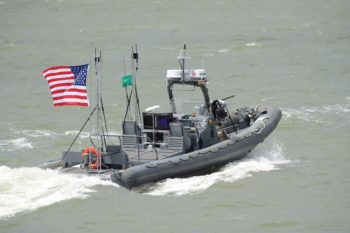The U.S. Office of Naval Research took to the lower Chesapeake Bay recently to show off their new autonomous unmanned swarming boats.
The unmanned boats, mainly of rigid hull inflatable boats (RHIBs) and other small boats, use a network of software, radar and other sensors to get a collectively “swarm” and perform patrol missions autonomously, with only remote human supervision.
During the demo, unmanned boats were given a large area of open water to patrol. As an unknown vessel entered the area, the group of swarmboats collaboratively determined which patrol boat would quickly approach the unknown vessel, classify it as harmless or suspicious, and communicate with other swarmboats to assist in tracking and trailing the unknown vessel while others continued to patrol the area. During this time, the group of swarmboats provided status updates to the human supervisor.
“This demonstration showed some remarkable advances in autonomous capabilities,” said Cmdr. Luis Molina, military deputy for ONR’s Sea Warfare and Weapons Dept. “While previous work had focused on autonomous protection of high-value ships, this time we were focused on harbor approach defense.”
The ONR calls the autonomy technology Control Architecture for Robotic Agent Command and Sensing, or CARACaS. The ONR says components that make up CARACaS (some are commercial off-the-shelf) are inexpensive compared to the costs of maintaining manned vessels for some of the dull, dirty or dangerous tasks—all of which can be found in the work of harbor approach defense, experts say.
“The U.S. Navy knows our most important asset, without question, is our highly trained military personnel,” said Dr. Robert Brizzolara, the program officer at ONR who oversees the effort. “The autonomy technology we are developing for our Sailors and Marines is versatile enough that it will assist them in performing many different missions, and it will help keep them safer.”
In 2014, ONR completed the first major demonstration of CARACaS technology on the James River in Virginia. At that time, the transportable kit containing the autonomy package was installed on multiple RHIBs, allowing them to operate in sync with other unmanned vessels, swarming to intercept potential enemy ships and escorting naval assets.
The demonstration held this year in October built upon that successful demo. Brizzolara says that substantial additional capability has been added to CARACaS since the 2014 demo, including the ability for multiple unmanned surface vehicles (USVs) to collaborate on task allocation; the development of additional USV behaviors and tactics; and advances in automated vessel classification from imagery.
“This technology allows unmanned Navy ships to overwhelm an adversary,” added Molina. “Its sensors and software enable swarming capability, giving naval warfighters a decisive edge.”
